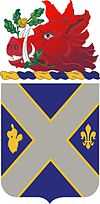121st Infantry Regiment (United States)
| 121st Infantry Regiment | |
|---|---|
|
Coat of arms | |
| Active | 1916 - 55 |
| Country |
|
| Allegiance | Georgia |
| Branch | Georgia Army National Guard |
| Type | Infantry |
| Nickname | "Old Gray Bonnet" |
| Motto | Faciendum Est (It Shall Be Done) |
| Engagements |
World War I World War II War in Afghanistan |
| Insignia | |
| Distinctive unit insignia |
 |
| U.S. Infantry Regiments | |
|---|---|
| Previous | Next |
| 120th Infantry Regiment | 122nd Infantry Regiment |
The 121st Infantry Regiment was an infantry regiment of the Georgia National Guard that saw combat service in the First and Second World Wars. As a result of army-wide reorganization in the 1950s, the 121st Infantry ceased to exist as a tactical unit. Today, some units of the Georgia National Guard trace their lineage to the 121st Infantry.
History
The 121st Infantry Regiment was formed from the 2nd Georgia Infantry Regiment in 1916 and assigned to the 31st Division. During World War One, the 121st was assigned to the 61st Infantry Brigade of the 31st Division.[1] The units of the 31st Division, including the 121st Infantry, were broken up upon arrival at Brest and used to provide replacements for other units at the front lines in France. The regiment was demobilized on 14 January 1919 at Camp Gordon, Georgia.[2]
After unit changes that saw the unit retitled 1st Infantry, Georgia National Guard and 122nd Infantry Regiment, the 121st Infantry Regiment was formed again as a Georgia National Guard unit in Macon, Georgia, and federally recognized on 9 June 1924. At this time, the regiment was also assigned to the 30th Division. The regiment was activated in 1925 because of hurricane damage at Tybee Island, and was activated again in 1934 to confront striking textile workers in the Georgia towns of Griffin, Jackson, and Rome.[2] On 22 November 1941, the regiment was relieved of assignment to the 30th Division and assigned to the 8th Division (later retitled "8th Infantry Division"). The regiment was briefly organized as a motorized infantry regiment before reverting to traditional infantry organization prior to shipping overseas. The 121st Infantry subsequently saw combat with the 8th Infantry Division in the European Theater of Operations during 1944-45.
The regiment returned from World War II at the Boston port of entry on 11 July 1945 and then moved to Fort Leonard Wood, Missouri, where it was inactivated on 20 October 1945.[3] In September 1946, the 121st Infantry Regiment was assigned to the 48th Infantry Division, a national guard division headquartered in Jacksonville, Florida. In 1955, this division became the 48th Armored Division and moved its headquarters to Macon, Georgia. As a result of this reorganization, the 121st Infantry Regiment ceased to exist as a tactical organization. Some elements of the 121st Infantry were transferred to the 162nd Tank Battalion in May 1956.[4][5] As the army adopted the Pentomic structure in the late 1950s, infantry regiments were broken up and the component battalions reassigned to brigade headquarters while still retaining the number of their former regiment in their titles. Thus, while the 121st Infantry has not existed as a separate tactical organization since the mid-1950s, some Georgia National Guard battalions, such as 2nd Battalion, 121st Infantry Regiment are still affiliated with the regiment, but assigned to brigades such as the 48th Infantry Brigade for purposes of tactical organization.
Battalions of the former 121st Infantry were assigned to the 48th Armored Division from 1959 until 1968, the 30th Infantry Division from 1968 through 1973, and 48th Infantry Brigade from 30 November 1973 to present.[6]
Distinctive unit insignia
The regimental nickname "The Gray Bonnets" is derived from the title of a song, "Put on Your Old Gray Bonnets" adopted in 1928 as the official air, or marching song, of the regiment. The distinctive unit insignia of the regiment is an "Old Gray Bonnet" proper, and is one of the few DUIs in the U.S. Army designed to be manufactured and worn in pairs (left and right).
The insignia is a blue shield with a gray saltire cross and a prickly pear and fleur-de-lis and a Boar's Head with an oak branch in its mouth on top. The blue background represents the Infantry while the gray cross symbolizes the unit's Confederate Service. The cactus represents duty on the Mexican border, and the fleur-de-lis service in France during World War I. The Boar's Head with oak leaf is the crest of the Georgia Army National Guard.
The distinctive unit insignia was originally approved for the 121st Regiment Infantry, Georgia National Guard on 27 June 1928. It was amended to permit manufacturing in pairs on 16 August 1928. It was redesignated for the 162d Tank Battalion, Georgia National Guard on 24 May 1956. The insignia was redesignated for the 121st Infantry, Georgia National Guard on 17 April 1961.
See also
Notes and sources
-
 This article incorporates public domain material from the United States Army Institute of Heraldry document "121 Infantry".
This article incorporates public domain material from the United States Army Institute of Heraldry document "121 Infantry". -
 This article incorporates public domain material from websites or documents of the United States Army Center of Military History.
This article incorporates public domain material from websites or documents of the United States Army Center of Military History.
- ↑ Brief histories of divisions, U.S. Army, p. 39, Historical Branch, War Plans Division, June 1921
- ↑ 2.0 2.1 Steven E. Clay, U.S. Army Order of Battle 1919-1941, p. 415, Fort Leavenworth: Combat Studies Institute Press, 2010
- ↑ Shelby L. Stanton, World War II Order of Battle, p. 291, New York: Galahad Books, 1991
- ↑ The Institute of Heraldry
- ↑ usmilitariaforum.com
- ↑ Timothy Aumiller, United States Army Infantry, Armor/Cavalry, Artillery Battalions 1957-2011, p. 26, Orbat.com for Tiger Lily Publications, 2011
